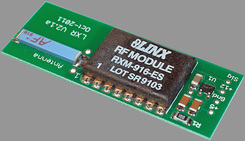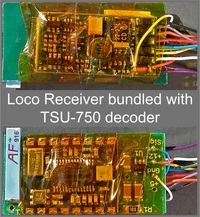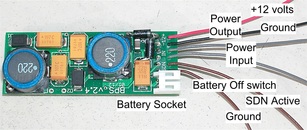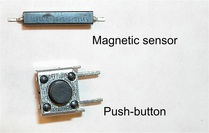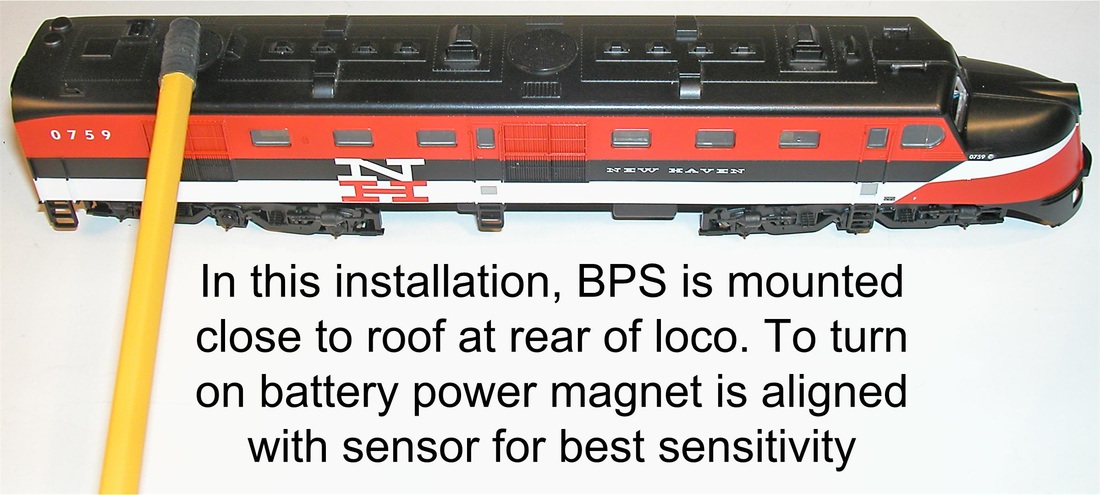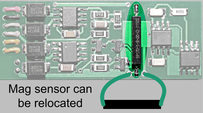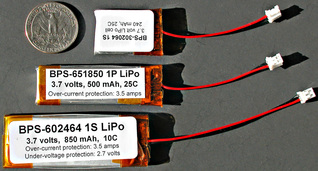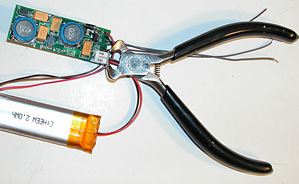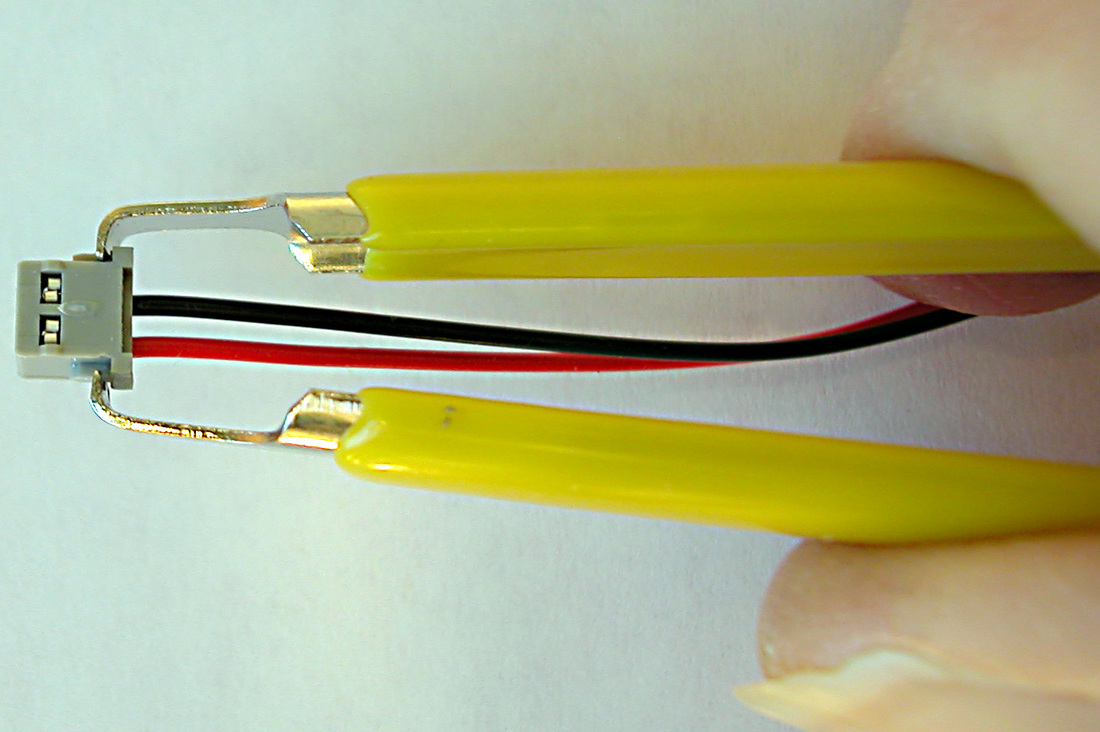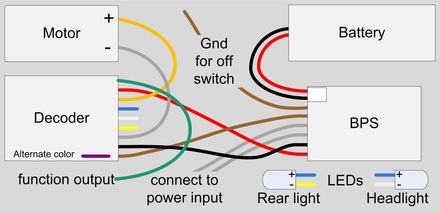Getting Started
If you're reading this, you probably just received your S-CAB package. It may be:
- a radio control system; most likely an S-CAB Starter Kit
- a BPS battery power supply
- both of these subsystems.
What's in the package?
|
The Starter Kit contains:
|
Contents of the BPS package will be:
|
First, put the Throttle and USB cable to one side and take a look at the S-CAB Throttle Quick Start Guide. There's not much to do, except turn on the throttle and figure out how to use it. If the display becomes dim (especially the right-hand character) use the USB cable to recharge.
Now consider the remaining components. The decoder, radio receiver, battery power supply and battery all go into the loco. There may be several additional items in the box; a speaker, for example, but leave them for the moment while we take a look at the major components for the loco.
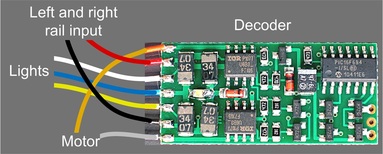
Decoder:
If the package contains a DCC decoder, it will be either sound or non-sound from one of several manufacturers. If not familiar with decoders, please review manufacturer's documentation. Connections and wiring colors are defined by NMRA standards, which helps significantly during installation. For example, the figure to the right shows two function outputs; white for headlight and yellow for rear light. Standards also cover decoders with 9-pin JST connectors and two more function outputs, which are assigned colors green and brown or violet.
If the package contains a DCC decoder, it will be either sound or non-sound from one of several manufacturers. If not familiar with decoders, please review manufacturer's documentation. Connections and wiring colors are defined by NMRA standards, which helps significantly during installation. For example, the figure to the right shows two function outputs; white for headlight and yellow for rear light. Standards also cover decoders with 9-pin JST connectors and two more function outputs, which are assigned colors green and brown or violet.
|
S-CAB Receiver:
A choice of antennas is available with the length-wise mounted ceramic chip (photo left) being the default selection. Unless requested otherwise, decoder and receiver will be bundled back-to-back, as illustrated to the right. In this figure, a cross-wise mounted antenna is used to create a very compact package. |
|
Battery Power Supply (BPS):
The BPS circuit board has six wire connections and a battery socket. The latest version (figure to left) has two diodes that were not on earlier boards and a color change from orange to brown for the battery off-switch connection. Two switches (figure to right) are now included with the BPS. Their use is optional, as will be explained later. |
|
A BPS delivery also includes a magnet, which will turn on battery power when moved close (within half an inch) of the on-board magnetic sensor. If possible, the BPS circuit board should be mounted close to the roof or side of a loco. If that is not convenient, relocate the sensor from the board (or use a second sensor) wired as shown in figure to right.
|
|
Not every toolkit includes an end-cutter. Pliers with serrated jaws may do the job.
|
Battery:
BPS batteries are either one cell or two lithium polymer (LiPo) cells connected in parallel (1P or 2P) and include battery protection. At present, there is a choice of 3 cell sizes; 850, 500 and 240 mAhs. When delivered, batteries will be charged to approximately 3.85 volts and will have been tested with the BPS. To repeat the BPS and battery test, plug the battery into the BPS, connect a voltmeter to BPS output (red and black wires) and move the magnet wand over the BPS sensor. The measured voltage will generally be between 11.5 and 12.5 volts.
|
Getting Started on the Workbench
|
For battery power projects, NCE's D13DRJ is a 4-function decoder with an S-CAB compatible radio receiver on the rear of the decoder circuit board.
|
Based on currently available decoders, NCE D13 series or SoundTraxx Tsunami decoders are the recommended choices and, most likely, one of them is in your package. Both decoders have 9-pin JST sockets and wire harness with matching plug and generous length of wire.
The TSU-750, which is an alternative for installations requiring minimum space, has directly wired leads and 2 function outputs.
|
Unless specified otherwise, the TSU-1000 will be bundled with an S-CAB loco receiver. It has 4 function outputs. one of which can be used to turn off battery power.
|
|
When components are removed from envelopes, there will be quite a tangle of wires, but connections will already be made for the red, black and brown wires between decoder and BPS. (The decoder brown wire may be purple/violet). Unnecessarily long wires add to the clutter and can be cut to appropriate length during installation. Wires already connected can be cut and rejoined, but don't do any cutting until bench testing is completed.
It's best to begin by repeating tests that were performed before shipping the system. The simplest test requires no cutting or connecting of wires. Just plug in the battery and move the magnet (the pencil) over the BPS sensor to turn on battery power. However, there won't be much to see (or hear) unless a motor and/or speaker is connected.
|
|
If you have a sound decoder, go ahead and connect a speaker. Add a motor, if convenient. For a non-sound decoder, connect motor and/or lights. There is no need to connect power to the BPS gray wires and the unconnected brown ground wire for a separate battery off switch can be ignored.
Test Sound:
On the throttle, press 'FG1' Press '1' to sound the bell, '2' for horn or whistle. Move the throttle to test the engine sound. Press '8' to turn off sound, press to restore sound. Use throttle F5 command to turn off battery:
Press 'FG1', then press '5' to turn off battery power. Since function outputs toggle between on and off states with each button press, 2 or even 3 button presses may be necessary. Convince yourself that this works by turning off power while sound is on and/or the motor is spinning. It's important to practice this control while the battery is easily accessible and can be unplugged if F5 does not work for some reason. |
|
